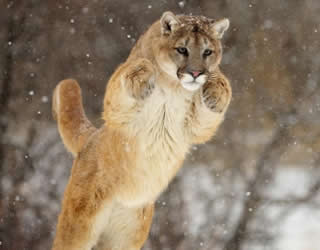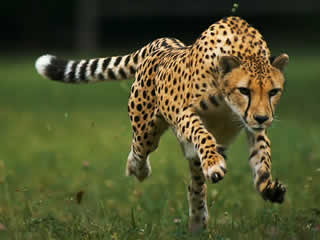Difference between Puma and Cheetah
Key difference: Puma and Cheetah are totally different big cats. Puma is large, slender cat with a small head. The puma is predominantly light brown, though individuals vary from gray to reddish-brown. On the other hand, Cheetah is a smaller size, spotted coats, small heads, ears and distinctive "tear stripes" that stretches from the corner of the eye to the side of the nose.
 Puma is also known as a cougar or a mountain lion. They are huge wild cats, and run at huge speeds. It is usually tan colored, and they are 9ft tall. They are mainly seen at places such as the west coast of Canada, in the western half of the United States, including Alaska and Florida, and most of Central and South America. The puma is a nocturnal hunter and hunts a large variety of prey, from deer and moose, to cattle, horses and even rodents. The Pumas is the largest of all the small cats, and have a recognizable facial characteristic of a black ring reaching from the corners of the mouth and around the nose.
Puma is also known as a cougar or a mountain lion. They are huge wild cats, and run at huge speeds. It is usually tan colored, and they are 9ft tall. They are mainly seen at places such as the west coast of Canada, in the western half of the United States, including Alaska and Florida, and most of Central and South America. The puma is a nocturnal hunter and hunts a large variety of prey, from deer and moose, to cattle, horses and even rodents. The Pumas is the largest of all the small cats, and have a recognizable facial characteristic of a black ring reaching from the corners of the mouth and around the nose.
The Puma is a solitary animal with the exception of the time cubs spend with their mother. The Puma is a large and powerful carnivore, hunting and eating only other animals in order to survive. It is one of the most dominant predators throughout much of their natural environment and is therefore rarely preyed upon by other species.
 A cheetah will carry its kill to a solitary hidden location to save the kill from other animals. Cheetah is the fastest land animal in the world. Cheetahs have been known to depend on their bursts of speed in order to hunt down victims. Cheetahs can go from 0-60 miles per hour in three seconds. Cheetahs are tan in color with black spots all over their bodies. They can also be distinguished from other big cats by their smaller size, spotted coats, small heads, ears and distinctive "tear stripes" that stretch from the corner of the eye to the side of the nose. They hunt during the day and rely on bursts of speed (up to 75mph over short distances). Unlike leopards and other big cats, they can purr while they inhale, but can't roar.
A cheetah will carry its kill to a solitary hidden location to save the kill from other animals. Cheetah is the fastest land animal in the world. Cheetahs have been known to depend on their bursts of speed in order to hunt down victims. Cheetahs can go from 0-60 miles per hour in three seconds. Cheetahs are tan in color with black spots all over their bodies. They can also be distinguished from other big cats by their smaller size, spotted coats, small heads, ears and distinctive "tear stripes" that stretch from the corner of the eye to the side of the nose. They hunt during the day and rely on bursts of speed (up to 75mph over short distances). Unlike leopards and other big cats, they can purr while they inhale, but can't roar.
Comparison between Puma and Cheetah:
|
|
Puma |
Cheetah |
|
Technical term |
Puma concolor |
Acinonyx jubatus |
|
Family |
Felidae |
Felidae |
|
Genus |
Puma |
Acinonyx |
|
Phylum |
Chordata |
Chordata |
|
Kingdom |
Animalia |
Animalia |
|
Class |
Mammalia |
Mammalia |
|
Order |
Carnivora |
Carnivora |
|
Speed |
64 to 80 km per hour |
112 to 120 km per hour |
|
Habitation |
West coast of Canada, in the western half of the United States, including Alaska and Florida, and most of Central and South America |
Africa and parts of Middle East |
|
Cats |
Puma is the largest wild cat animal of the four cats. |
Cheetah is the fastest wild cat animal of the four cats. |
|
Weight |
29 to 90 kg |
35 to 65 kg |
|
Fur |
Pumas are yellowish animal, referring to tiger. |
The short fur of the cheetah is tan with round black spots. They are single large spots resembling thumb prints. |
|
Hunt |
A puma’s killing bite is applied to the back of the neck, head, or throat and inflicts puncture marks with their claws usually seen on the sides and underside of the prey, sometimes also shredding the prey as they hold on. |
When it sights prey, the cheetah often begins to stalk. It creeps as close as possible before the attack. It may lift its head high to keep the prey in sight. But it keeps its body hidden. |
|
Vocalization |
Puma never roar, instead it can growl, hiss, screech and purr. |
A Cheetah cannot roar, but instead of that he uses growling and yowling. |
|
Prey |
They eat small to medium animals, but they more prefer to eat small animals like Mice, Rats, Birds, Fish and Rabbits. |
They eat small- to medium-size animals, such as hares, impalas, wildebeest calves, and gazelles. |
Image Courtesy: animals.desktopnexus.com, infinitylist.com









Comments
palmares mundia...
Sun, 03/25/2018 - 12:48
zomb
Tue, 10/10/2017 - 21:06
Add new comment